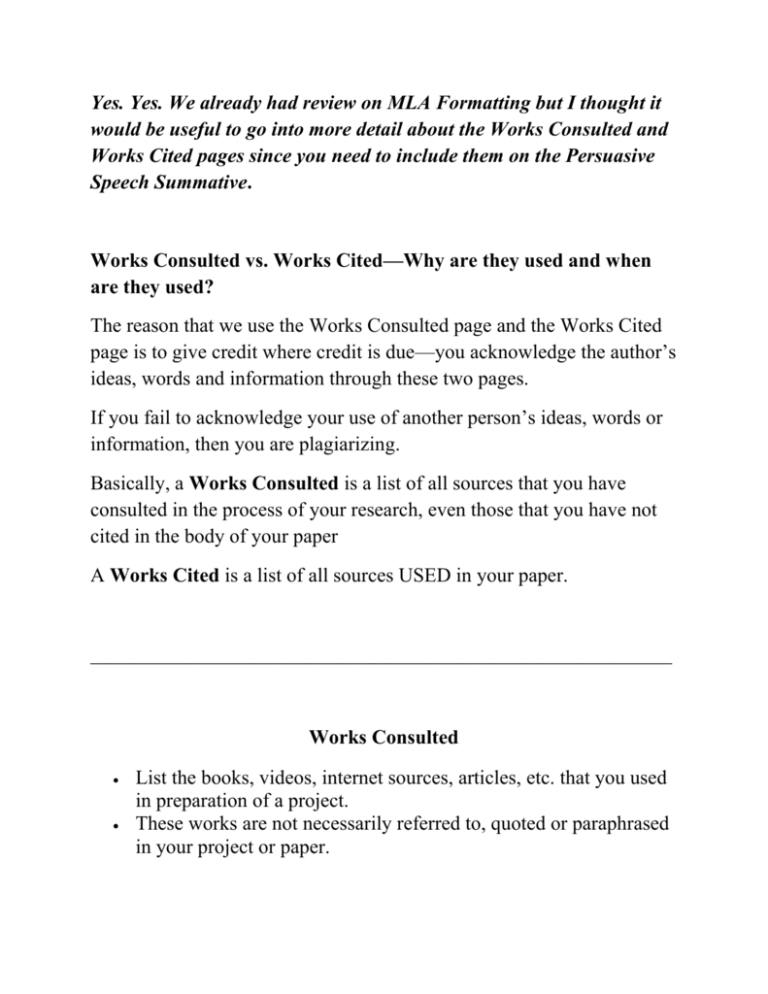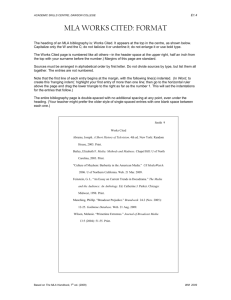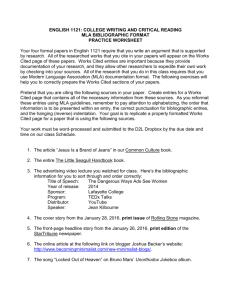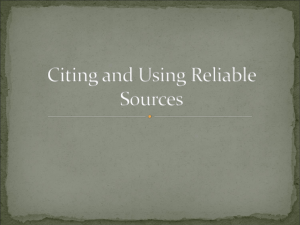Works Consulted - O'Hearn's English Page
advertisement

Yes. Yes. We already had review on MLA Formatting but I thought it would be useful to go into more detail about the Works Consulted and Works Cited pages since you need to include them on the Persuasive Speech Summative. Works Consulted vs. Works Cited—Why are they used and when are they used? The reason that we use the Works Consulted page and the Works Cited page is to give credit where credit is due—you acknowledge the author’s ideas, words and information through these two pages. If you fail to acknowledge your use of another person’s ideas, words or information, then you are plagiarizing. Basically, a Works Consulted is a list of all sources that you have consulted in the process of your research, even those that you have not cited in the body of your paper A Works Cited is a list of all sources USED in your paper. __________________________________________________________ Works Consulted List the books, videos, internet sources, articles, etc. that you used in preparation of a project. These works are not necessarily referred to, quoted or paraphrased in your project or paper. Other names for Works Consulted are Selected Bibliography or Selected List of Works Consulted. Works Cited List the book, videos, websites, etc. that you actually referred to, paraphrased or quoted in your project. You cite the resource when you find ideas, information or words that are important in presenting your project or paper. You want to give credit to the author for their information, ideas or words. Example: when you write in your project or paper, " As Maya Angleou has suggested..", then you need to cite the source. Other names for a Works Cited, page are Bibliography and Literature Cited When to use Use only a Works Cited page when you quote or paraphrase all the resources you consulted. Use a Works Consulted page when you used sources for background information but do not directly refer to, quote or paraphrase the work in your project. Tips to remember Follow the citation format your teacher wants, in our case, MLA. Keep a list of the articles or webpages you are citing and consulting. For websites, remember to write down the date you accessed the website. Don 't put quotation marks around the Works Cited and Works Consulted titles in your project. The Works Cited or Works Consulted page goes at the end of the paper. If both a Works Consulted page and Works Cited page are used the Works Consulted page goes first. (MLA Style) Source: http://www.lschs.org/page.cfm?p=1621 __________________________________________________________ MLA Works Cited Page: Basic Format (https://owl.english.purdue.edu/owl/resource/747/05/) According to MLA style, you must have a Works Cited page at the end of your research paper. All entries in the Works Cited page must correspond to the works cited in your main text. Basic rules Begin your Works Cited page on a separate page at the end of your research paper. It should have the same one-inch margins and last name, page number header as the rest of your paper. Label the page Works Cited (do not italicize the words Works Cited or put them in quotation marks) and center the words Works Cited at the top of the page. Double space all citations, but do not skip spaces between entries. Indent the second and subsequent lines of citations by 0.5 inches to create a hanging indent. List page numbers of sources efficiently, when needed. If you refer to a journal article that appeared on pages 225 through 250, list the page numbers on your Works Cited page as 225-50. Note that MLA style uses a hyphen in a span of pages. Additional basic rules new to MLA 2009 New to MLA 2009: For every entry, you must determine the Medium of Publication. Most entries will likely be listed as Print or Web sources, but other possibilities may include Film, CD-ROM, or DVD. Writers are no longer required to provide URLs for Web entries. However, if your instructor or publisher insists on them, include them in angle brackets after the entry and end with a period. For long URLs, break lines only at slashes. If you're citing an article or a publication that was originally issued in print form but that you retrieved from an online database, you should type the online database name in italics. You do not need to provide subscription information in addition to the database name. Capitalization and punctuation Capitalize each word in the titles of articles, books, etc, but do not capitalize articles (the, an), prepositions, or conjunctions unless one is the first word of the title or subtitle: Gone with the Wind, The Art of War, There Is Nothing Left to Lose. New to MLA 2009: Use italics (instead of underlining) for titles of larger works (books, magazines) and quotation marks for titles of shorter works (poems, articles) Listing author names Entries are listed alphabetically by the author's last name (or, for entire edited collections, editor names). Author names are written last name first; middle names or middle initials follow the first name: Burke, Kenneth Levy, David M. Wallace, David Foster Do not list titles (Dr., Sir, Saint, etc.) or degrees (PhD, MA, DDS, etc.) with names. A book listing an author named "John Bigbrain, PhD" appears simply as "Bigbrain, John"; do, however, include suffixes like "Jr." or "II." Putting it all together, a work by Dr. Martin Luther King, Jr. would be cited as "King, Martin Luther, Jr." Here the suffix following the first or middle name and a comma. More than one work by an author If you have cited more than one work by a particular author, order the entries alphabetically by title, and use three hyphens in place of the author's name for every entry after the first: Burke, Kenneth. A Grammar of Motives. [...] ---. A Rhetoric of Motives. [...] When an author or collection editor appears both as the sole author of a text and as the first author of a group, list solo-author entries first: Heller, Steven, ed. The Education of an E-Designer. Heller, Steven, and Karen Pomeroy. Design Literacy: Understanding Graphic Design. Work with no known author Alphabetize works with no known author by their title; use a shortened version of the title in the parenthetical citations in your paper. In this case, Boring Postcards USA has no known author: Baudrillard, Jean. Simulacra and Simulations. [...] Boring Postcards USA. [...] Burke, Kenneth. A Rhetoric of Motives. [...] Further information on the Works Consulted can be found at: https://owl.english.purdue.edu/owl/resource/978/07/ Further information on the Works Cited can be found at: https://owl.english.purdue.edu/owl/resource/747/12/ A PowerPoint presentation on MLA Style Formatting can be found at: https://owl.english.purdue.edu/owl/resource/747/15/ For a more complete list of source citation (from the University of Western Ontario), please go to: https://www.lib.uwo.ca/files/styleguides/MLA.pdf






